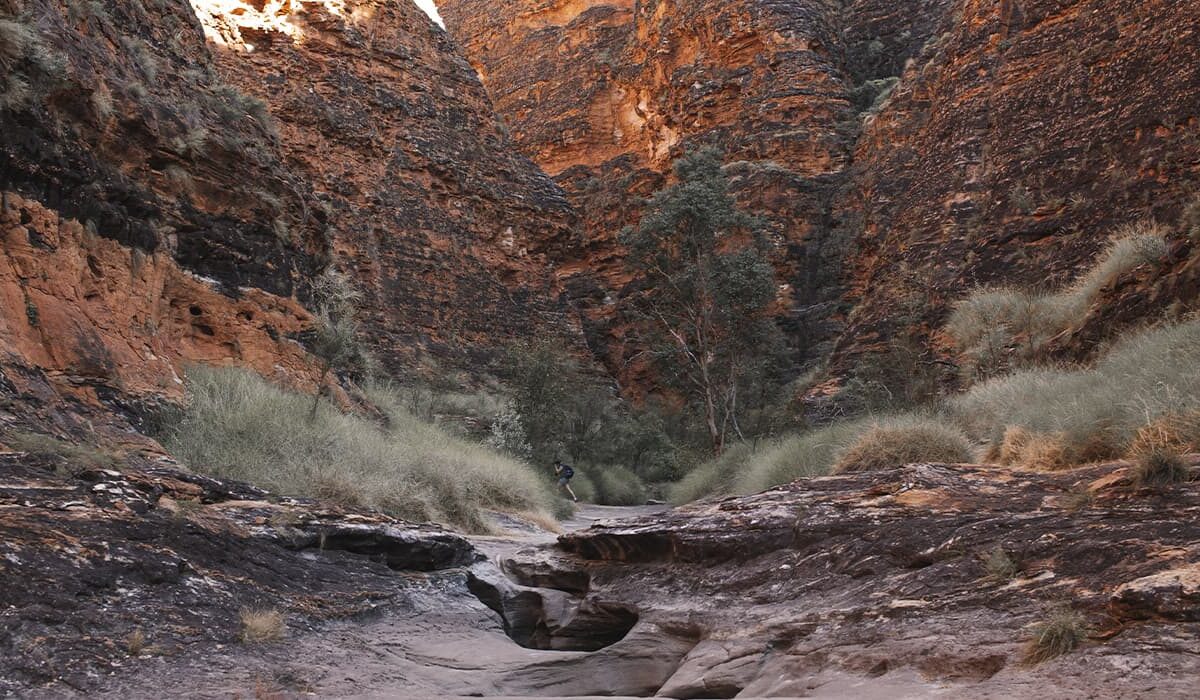Purnululu National Park is one of the most geologically interesting parks in Western Australia, a veritable open-air museum. In 1987 the park, covering 240,000 hectares on the Kimberley Plateau, was inscribed on the UNESCO World Heritage List. The nature of these places is truly pristine and unspoiled – the nearest settlement is 250 km from the park.
Sometimes the park is called the Bungle Bungle after the names of the namesake mountain range that makes up the entire park.
The terrain in the park is very varied: the already mentioned 45,000 hectares of the Bungle Bungle Range, vast sandy plains, grassy lowlands in the Ord River valley and limestone cliffs in the west and east of the park.
The main attraction of Purnululu Park are the mountain formations of the Bungle Bungle Range, which took the form of beehives as a result of erosion processes over 20 million years. These “hives” have an interesting structure – bright orange sandstone alternates with dark bands several meters wide. Their bright orange color is due to the iron and manganese oxides.
The arid climate has caused the formation of two ecosystems here – northern tropical savannahs and inland arid deserts. The flora of the park is represented by sparse woodlands and meadows with numerous eucalyptus, acacia, and grevillea trees. A total of 653 plant species are found here, 13 of which are relicts. Fauna is poorer in terms of species – the park has 41 species of mammals, 81 species of reptiles, 15 species of fish and 149 species of birds.
The territory of the park had a great economic and cultural significance among the aboriginal tribes – about 200 rock paintings of ancient people and burials have been found here. But Europeans, due to arid climate and inhospitable natural conditions, bypassed these places. The first herders came here only in the late 19th century, and an amazing mountain formations Bang Bangl Range was first discovered to the world only in 1982!
Camping in Purnululu
There are two campsites, one larger, Kurrajong, at the northern end of the park.
The other smaller one is Walardi in the south.
Kurrajong Camping
Kurrajong Camping has three areas (loops) for overnight stays.
I recommend going straight to Loop 3, it is separated from the other two, farther away and less crowded.
The area has toilets (booths with a tin bucket inside, no flush) and water taps next to them.
If you are squeamish about going to the booths, you can go to the bushes – this is a good Loop 3.
But be sure to shine your flashlight in the grass and bushes at dusk – there might be snakes and spiders like tarantulas for sure.
The camping ground is numbered, but if you don’t have enough people, you can scatter camping on several places, thus fencing off from neighbors (again Loop 3).
Everyone tries to be placed at a distance from each other.
The campers go to bed two hours after sunset. The campsite is quiet.
Walardi Camping
The Walardi campsite is where I stayed when I first came to Purnululu.
It is small and greener – more shade, although you don’t need any shade at all in the evening.
Walardi is closer to Purnululu’s calling card, the Striped Eggs and Katerdal Cave.
But part of the campsite is noisy – generators are allowed there.
Another part of the campsite is reserved for organized tourists, who are brought by buses and settled in tents.
Visitor center Purnululu.
When you enter the park, at the Visitor center Purnululu you have to pay to enter the park and spend the night in the camping.
Although they write the name of the campsite you are going to stay in on a piece of paper you have to put under the windshield, you don’t have to get attached to it.
Take the time to see both and make your own choice, as everyone’s taste is different.
What to see in Purnululu
The visitor center will give you two maps – of the northern and southern parts of Purnululu Park.
They are not the same.
The maps show the points of interest in this area of the park and the hiking trails.
You have to hike a lot – you have to be prepared for that.
There are tracks with overnight stay, but you need short (not more than 4 km) tracks.
Of course you need comfortable shoes – you will have to walk on stones and on sand.
Be sure to have a sun hat and plenty of water.
The truth we went in flip-flops, without hats, and with one bottle of 0,33 for two – it was extreme.
The southern part of Purnululu.
The calling card is Catherdal Gorge, a huge cave with a body of water.
In the rainy season there is a large waterfall, in the dry season there is a pond with cool water in which you can swim.
There are fish in the pond that can bite your legs – they are harmless and do not bite above your feet.
Dome Walk is a trail to a smaller cave.
North of Purnululu.
Echidna Chasm – a narrow gorge, with clumps stuck in crevices.
It ends in a room with steep walls – in the rainy season there is a waterfall here.
Mini Palms Gorge is a gorge with small palm trees growing in it.
Ten years ago there were more of them, from which I conclude that soon there will be no more of them at all – climate change.

